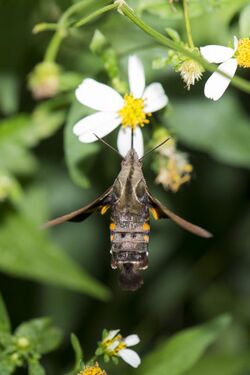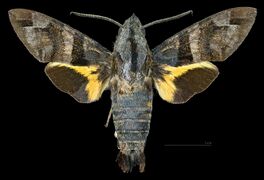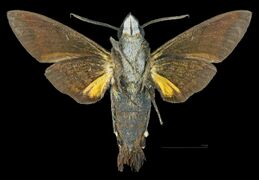Biology:Macroglossum heliophila
| Broad-bordered hummingbird hawkmoth | |
|---|---|

| |
| Scientific classification | |
| Domain: | Eukaryota |
| Kingdom: | Animalia |
| Phylum: | Arthropoda |
| Class: | Insecta |
| Order: | Lepidoptera |
| Family: | Sphingidae |
| Genus: | Macroglossum |
| Species: | M. heliophila
|
| Binomial name | |
| Macroglossum heliophila Boisduval, 1875[1]
| |
| Synonyms | |
| |
Macroglossum heliophila, the broad-bordered hummingbird hawkmoth, is a moth of the family Sphingidae. It was described by Jean Baptiste Boisduval in 1875. It is found from north-eastern Sikkim, India across southern China to Cheju Island (South Korea), southern Japan , Taiwan and the Philippines and then south through Vietnam, Thailand, Malaysia and Indonesia to New Guinea and neighbouring islands. It is also known from Queensland, but doubt in Sri Lanka.
Description
The wingspan is 50–60 mm. Head, thorax, and first two abdominal segments are rufus coloured. Third and fourth abdominal segments are with latrea; yellow bands and paired black dorsal spots. There is a black dorsal spot on the terminal segment. Ventral side is reddish. Forewings are greyish brown. Antemedial band is wide and recurved along the inner margin. Two curved postmedial diffused bands which are dark with reddish brown can be seen on their inner sides. Subapical markings are indistinct. Hindwings and ventral side is similar to Macroglossum sitiene.[2]
There are two main colour forms in larva. In the green form, the head is yellowish green with the basal segment of the antenna greenish. Other segments are red. Eyes brownish. In the dark-coloured form, the head is pale brown. Body dark smoky olive green or olive brown, dotted with white. A bluish-black dorsal stripe is present. Horn reddish in both forms. Pupa is pinkish bone colour, but head, thorax and wing-case tinged with green.[3]
Ecology
There are several generations per year in Hong Kong, with adults on wing in April and from June to December.[4]
The larvae feed on Psychotria rubra in Hong Kong and Psychotria dalzellii in India. Other recorded food plants include Morinda species. There are green, reddish brown and black forms of the fully grown larva. Early instars are blood red with honey yellow at the anterior and posterior, the red fading and the body becoming greener with growth.[5]
Subspecies
- Macroglossum heliophila heliophila
- Macroglossum heliophila divergens Walker, 1856 (Sri Lanka)
- Macroglossum heliophila queenslandi Clark, 1927 (Queensland)
References
- ↑ "CATE Creating a Taxonomic eScience - Sphingidae". Cate-sphingidae.org. Archived from the original on 2012-10-01. https://web.archive.org/web/20121001185621/http://www.cate-sphingidae.org/taxonomy/Macroglossum/heliophila.html. Retrieved 2011-10-25.
- ↑ Hampson, G. F. (1892). The Fauna of British India, Including Ceylon and Burma: Moths Volume I. Taylor and Francis. https://www.biodiversitylibrary.org/item/180068#page/5/mode/1up.
- ↑ Pittaway, A. R.; Kitching, I. J.. "Macroglossum divergens heliophila Boisduval, [1875 -- Broad-bordered hummingbird hawkmoth"]. http://tpittaway.tripod.com/china/m_hel.htm. Retrieved December 15, 2018.
- ↑ Herbison-Evans, Don; Crossley, Stella (10 February 2016). "Macroglossum heliophila (Boisduval, [1875)"]. http://lepidoptera.butterflyhouse.com.au/sphi/heliophila.html. Retrieved 18 November 2018.
- ↑ "Macroglossum heliophila Boisduval". http://www.mothsofborneo.com/part-3/sphingidae/sphingidae_28_15.php. Retrieved 18 November 2018.
Wikidata ☰ Q2019195 entry



